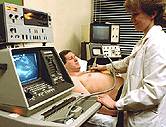
MONDAY, July 12 (HealthDay News) — Patients who have a heart attack and undergo procedures to open blocked arteries are getting proven treatments in U.S. hospitals faster and more safely than ever before, according to the results of a large-scale study.
Data on more than 131,000 heart attack patients treated at about 250 hospitals from January 2007 through June 2009 also showed that the patients themselves have become more aware of the signs of heart attack and are showing up at hospitals faster for help.
Lead researcher Dr. Matthew T. Roe, an associate professor of medicine at Duke University Medical Center and the Duke Clinical Research Institute, thinks a combination of improved treatment guidelines and the ability of hospitals to gather data on the quality of their care accounts for many of the improvements the researchers found.
“We are in an era of health care reform where we shouldn’t be accepting inferior quality of care for any condition,” Roe noted.
“Patients should be aware that we are trying to be on the leading edge of making rapid improvements in care and sustaining those,” he added. “Patients should also be aware that the U.S. is on the leading front of cardiovascular care worldwide.”
The report is published in the July 20 issue of the Journal of the American College of Cardiology.
Roe’s team, using data from two large registry programs of the American College of Cardiology Foundation’s National Cardiovascular Data Registry, found there were significant improvements in a number of areas in heart attack care:
- An increase from 90.8 percent to 93.8 percent in the use of treatments to clear blocked blood vessels.
- An increase from 64.5 percent to 88 percent in the number of patients given angioplasty within 90 minutes of arriving at the hospital.
- An improvement from 89.6 percent to 92.3 percent in performance scores that measure timeliness and appropriateness of therapy.
- Better prescribing of blood thinners.
- A significant drop in hospital death rates among heart patients.
- Improvement in prescribing necessary medications, including aspirin, anti-platelet drugs, statins, beta blockers, angiotensin-converting enzyme inhibitors and angiotensin-receptor blockers.
- Improvement in counseling patients to quit smoking and referring patients to cardiac rehabilitation.
In addition, patients were more aware of the signs of heart attack and the time from the onset of the attack until patients arrived at the hospital was cut from an average 1.7 hours to 1.5 hours, the researchers found.
Roe’s group also found that for patients undergoing an angioplasty:
- There was an increase in the complexity of the procedure, including more patients with more challenging conditions.
- There were reductions in complications, including bleeding or injury to the arteries.
- There were changes in medications to prevent blood clots, which reflect the results of clinical trials and recommendations in new clinical practice guidelines.
- And there was a reduction in the use of older drug-eluting stents, but an increase in the use of new types of drug-eluting stents.
Despite all the good news, Roe’s team said there was still room for improvement in care, particularly in ways to reduce the risk of bleeding that is present with even the most advanced treatments.
“We need to do ongoing and regular surveillance of care patterns” Roe said.
Dr. Gregg C. Fonarow, a cardiology professor at the University of California, Los Angeles, commented that “national clinical registries provide valuable data to characterize recent trends in the treatment and in-hospital clinical outcomes for patients hospitalized with cardiovascular disease or those undergoing cardiovascular procedures.”
This new report demonstrates improvements in the speed in which reperfusion is offered in heart attack patients, better use of guideline-recommended medications in heart attack patients, and decreases in complications in patients undergoing coronary procedures, Fonarow said.
“These findings show the substantial efforts to provide physicians and hospitals with detailed feedback on performance coupled with targeted quality improvement efforts are producing measurable and meaningful benefits to cardiovascular disease patients,” Fonarow added.
However, he said, there are further opportunities to improve care and clinical outcomes for patients with heart attacks and those undergoing cardiovascular procedures. Because “not all U.S. hospitals are participating in these voluntary clinical registries, there is a very important need to expand hospital participation,” Fonarow noted. Fonarow is the unpaid chair of the Get With The Guidelines committee of the American College of Cardiology ACTION registry.
More information
For more information on heart attacks, visit the American Heart Association.

